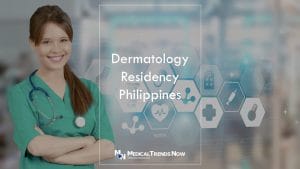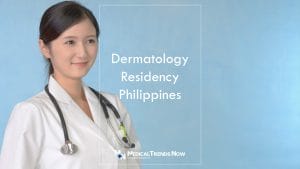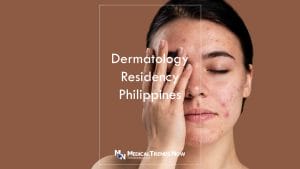Table of Contents
If you are interested in skincare, cosmetic surgery, aesthetic beauty, and a hefty salary, then you should consider the Dermatology Residency in the Philippines. Find out why becoming a dermatologist is a good choice and what are the benefits of being a dermatologist. If you want to become the most sought-after doctor by celebrities and high-income net-worth individuals, then dermatology residency might be the right specialization for you.
In this ultimate guide, we’ll give you more information about the dermatology residency program in the Philippines.
Dermatology residency training in the Philippines is an excellent way to gain experience in the field of dermatology. The dermatology residency in the Philippines offers a comprehensive curriculum that covers all aspects of dermatology, from diagnosis and treatment to research. The quality of care provided by the dermatologists at this institution is top-notch, and residents will have plenty of opportunities to participate in clinical trials and research projects.
The Philippines is an ideal location for a dermatology residency program, as the country has a large population of over 100 million people in Southeast Asia. The country’s warm climate and diverse geographic landscape provide residents with a variety of opportunities to practice dermatology.
What is Dermatology?
Dermatology is the study of the skin and its diseases.
It includes the diagnosis and treatment of skin conditions such as acne, eczema, psoriasis, and rosacea.
Dermatologists also specialize in skin cancer screening and treatment.
What Does a Dermatology Doctor Do?
A dermatologist is a doctor who specializes in the diagnosis, treatment, and prevention of skin diseases. The Filipino dermatologist will typically examine a patient’s skin and flag any abnormalities that may need treatment. A Filipino dermatologist may prescribe medications or treatments to correct the issue.
Dermatologists also work to educate their patients about skin health and how to keep it healthy.
They typically work in offices or clinics and may also have advanced training in other medical fields, such as surgery. Dermatologists often work with other healthcare professionals to treat patients with skin conditions.
Accredited Training Institutions for Dermatology Residency Training in the Philippines:
The Philippine Dermatological Society (PDS) and The Skin and Cancer Foundation, Inc. are organizations and accreditation institutions in the Philippines that supervises the community of dermatologists.
These organizations ensure quality and competent dermatologists adhere to the highest standards of skin health.
Philippine Dermatological Society (PDS)
Here are the Philippine Dermatological Society’s accredited institutions in the Philippines
- East Avenue Medical Center
- Makati Medical Center Department of Dermatology
- Research Institute for Tropical Medicine
- St. Lukes Medical Center Department of Dermatology
- University of the East Ramon Magsaysay Medical Center
- The University of Sto. Tomas Hospital Department of Dermatology
- Jose R. Reyes Memorial Medical Center
- Ospital ng Maynila Medical Center
- Rizal Medical Center – Department of Dermatology
- Skin and Cancer Foundation Inc.
- Southern Philippines Medical Center
- UP – Philippine General Hospital

The Skin and Cancer Foundation, Inc. (SCF)
The Skin and Cancer Foundation Inc.’s dermatology residency program offers a distinctive blend of conventional training through patient management in charitable clinics under the supervision of faculty personnel and early exposure to preceptorship with expert dermatologists.
In the outpatient clinics, where patients are primarily seen by residents under the supervision of faculty members, basic and essential dermatologic training is being taught by faculty members. Given that practicing dermatology is both a highly visual skill and an art, close preceptor supervision and one-on-one instruction are effective tools for giving residents a solid understanding of the holistic approach to dermatology practice.
After completing a three-year residency program, residents are qualified for diplomate status by the Philippine Board of Dermatology, which also qualifies them for certification and membership in the Philippine Dermatological Society (PDS).
There are three different rotations for dermatology training, each of which is overseen by a senior resident. Each SCF clinical facility hosts all teams for about four months:
- 1. Quirino Memorial Medical Center, is a public hospital that accepts all patients who are impoverished.
- 2. A free medical facility in Ospital ng Makati.
Annual records show almost 18,000 outpatient dermatology visits. In charitable hospitals, residents meet patients during the week and work with faculty personnel to handle inpatient referrals.
Eligibility and Program for Dermatology Residency in the Philippines
To be eligible for a dermatology residency program in the Philippines, applicants must have completed an accredited medical school and completed at least three years of residency training in a reputable medical university.
There are several factors when selecting candidates for residency programs in the Philippines, including previous experience working with patients with skin problems and knowledge of skin anatomy and pathology.
Advantages
Dermatology residencies in the Philippines offer a number of advantages over programs in other countries.
- First, many hospitals in the Philippines are private with impressive biomedical equipment, diagnostic tools, and treatment centers, which allows resident physicians to work effectively with local patients and their families.
- Second, the low cost of living in the Philippines makes it possible for residents to live relatively cheaply while pursuing their medical careers.
- Finally, Filipino medical students receive excellent training in dermatology, making them well-prepared to enter into clinical practice once they complete their residencies.
How Do I Apply for Dermatology Residency in the Philippines?
Dermatology residency programs in the Philippines are competitive, and many applicants receive multiple offers. The application process is typically lengthy and includes an interview with the residency program director.
Most programs require a medical school degree from an accredited institution, although some programs may accept graduates of allied health programs. Applicants should research available residency programs in the Philippines and prepare a detailed application that addresses their specific qualifications. Each hospital and medical center will have its own residency procedure.
According to RITM, Filipino physicians with board certification from the Philippines Medical Board of Examiners can apply to accredited institutions.
How Long is Dermatology Residency in the Philippines?
Dermatology residency training in the Philippines is a three-year program that prepares physicians to provide comprehensive care for Filipino patients with skin conditions. It is one of the more competitive programs in medicine, and applicants must have excellent academic records and demonstrate proficiency in both English and Tagalog.
During the first year, residents receive training in the diagnosis and treatment of common skin diseases, including skin cancer. They also learn how to manage patients with complex skin disorders such as HPV, eczema, and psoriasis.
In the second year, residency training focuses on advanced dermatological treatments. Residents learn about new surgical techniques for treating skin cancer and other serious diseases. They also learn about prevention strategies for skin diseases, including sun exposure avoidance and the use of biomedical equipment, diagnostic tools, and treatment innovations.
Residents who complete a dermatology residency in the Philippines provide valuable care to patients in local hospitals. They are able to provide comprehensive care for patients with a wide range of skin conditions, which can improve patient’s health.

What Happens After Dermatology Residency?
After completing a dermatology residency, many physicians are ready to practice dermatology full-time.
However, before doing so, they must complete additional training and board certification in order to be eligible to do so.
Board certification in dermatology is available through PDS.
After completing board certification, physicians are able to use the title “dermatologist.”
What to Expect During Your Dermatology Residency in the Philippines?
When you are choosing a dermatology residency, it is important to know what to expect.
During your residency, you will be learning about the different types of skin health problems and how to diagnose and treat them. You will also learn about the latest trends and treatment techniques for skin conditions using state-of-the-art technologies.
One of the most important things that you will learn during your dermatology residency is how to care for patients with skin diseases. You will need to know how to diagnose and treat these conditions quickly and correctly so that the patient can get the best possible care.
During your residency, you will also have opportunities to participate in clinical trials. This means that you can learn about new treatments or therapies before they are available to the public. This is an invaluable experience that can help you become a better doctor.
What are the Requirements for a Dermatology Residency In The Philippines?
There are many requirements for a dermatology residency, but the most important factor is the quality of care that the residency program provides. Residents must have a strong background in medicine and be able to provide excellent patient care. They must also have excellent communication and critical thinking skills, as well as experience managing complex cases.
In order to be accepted into a dermatology residency in the Philippines, you will need to have completed an undergraduate degree in a medical field, have excellent clinical skills, and have passed the Philippine Regulatory Commission Licensing Examination. Programs may also require you to have experience working as a doctor in another field, such as general surgery or internal medicine.
The Philippines has several dermatology residency programs that are accredited by the PDS and SCF. These programs typically offer residentships at private hospitals across the country.
How Do You Become a Board-Certified Dermatologist in the Philippines?
The physician must pass the Philippine Board of Dermatology’s board exams after completing their training for them to be given the designation “Board-Certified.”
Dermatologists are not “certified” medical professionals if they have only taken dermatology or aesthetics seminars.
To become a “certified” Dermatologist in the Philippines, the physician must complete the three-year residency program from one of the Philippine Board of Dermatology accredited institutions and pass the board exam.

How to Choose a Dermatology Residency Program In The Philippines?
There are many factors to consider when choosing a dermatology residency program. Some important considerations include the size of the program, the location, the type of training offered, and the opportunity for in-patient or outpatient residencies.
When comparing programs, it is important to look at both the number of clinical experience residents will have and the number of fellowships and teaching opportunities available.
Some factors to consider when making this comparison are:
- how many hours per week residents will be working;
- how much independence they will have;
- whether there is a dedicated dermatology resident assistant (DRA) or not;
- and whether residents will be able to work with specialty clinics in their area.
Other important factors to consider include curriculum content, faculty credentials, and research activity, hospital affiliations, cost of attendance, financial aid options, and housing arrangements.
It is also important to speak with current residents at different programs before making a decision so that you can get a feel for what life as a dermatologist resident will be like.
What are the Advantages of a Dermatology Residency In The Philippines?
Dermatology residency in the Philippines offers many advantages for both the doctor and the patient. The physician can gain a wealth of knowledge and experience in one specialty, while the patient can be assured of receiving world-class care from a highly respected physician.
Some of the major benefits include:
1. Increased Career Prospects – A dermatology residency in the Philippines is one of the most prestigious and sought-after medical specialties, which means that Filipino doctors who complete one will have increased career prospects.
2. Improved Patient Care – A dermatology residency program in the Philippines offers the world’s best training in skin care, which allows doctors to provide excellent care to their patients. This includes diagnosis and treatment of various skin conditions as well as prevention and management of skin cancer.
3. Greater Ability to Address Complex Cases – A dermatology residency program provides doctors with extensive training in managing complex cases, which allows them to provide exceptional care for their patients regardless of their severity or complexity.
There are many great dermatology residency programs in the Philippines, so whether you are interested in pursuing a career in medicine or just want to receive top-notch care for your skin condition, a residency program is a great option for Filipinos.
Challenges for Dermatology Residents in the Philippines
Dermatology residency in the Philippines presents many challenges for residents. The country has a tropical climate, and residents must deal with the humidity and heat.
If you are in Metro Manila, expect heavy traffic going to the hospital. So we suggest traveling early, around 1 to 2 hours preparation to go to the hospital.
Additionally, the country has a high incidence of skin cancer, which means that residents must be knowledgeable about all types of skin cancer and how to treat them.
In addition to treating patients, dermatology residents must also learn about skin care products and how to educate Filipinos about original skin products. Many Filipinos settle for fake or cheap products, which aggravate their skin problems.
Finally, residency programs in the Philippines often require students to complete several (long hours) clinical rotations before they can begin their residency training. These rotations give residents experience working with different patient populations and teaching them techniques that they will use during their residency training.
Essential Roles of a Dermatology Physician
Dermatology physicians typically work in clinics or hospitals, but they may also work in private practice.
The essential roles of a dermatology physician include diagnosing and treating skin disorders; advising patients on skin care; recommending surgery if necessary; and providing education about skin health.
How Much is the Salary of Dermatology Residents in the Philippines?
There is no definitive answer to this question as it can vary depending on the location and type of dermatology residency program.
However, according to several testimonials of resident doctors on YouTube channels, dermatology residents in the Philippines earn between Php 19,000 to Php 42,000. This figure is lower than those earned by residents in some other countries, but it is still relatively high when compared to other medical specialties.

How Many Types of Dermatology are There?
There are many types of dermatology, some of which include: general dermatology, pediatric dermatology, skin cancer treatment, eczema treatment, and psoriasis treatment.
Each type of dermatology has its own set of specialized knowledge and skills that must be mastered in order to provide the best possible care for patients.
Here are the types of dermatology sub-specialization in the Philippines:
Dermatoimmunology
Dermatoimmunology is the study of how the immune system interacts with the skin. This field of research is important because it can help us understand skin diseases and better treat them. For example, we know that some skin diseases are caused by infections, and we can use knowledge about the immune system to develop treatments that fight these infections. Dermatoimmunology also helps us understand how skin cells work and how they interact with the immune system. This knowledge can be used to help treat conditions like psoriasis and eczema.
Cosmetic Dermatology
Cosmetic dermatology is the branch of medicine that deals with the diagnosis and treatment of skin problems, including disorders of the skin and its appendages. This field of medicine has two main branches: general cosmetic dermatology, which deals with all types of skin problems, and specific cosmetic dermatology, which focuses on treating specific conditions such as acne, psoriasis, rosacea, and age spots. Cosmetic dermatologists typically hold a medical doctorate degree in either surgery or medical sciences. They may also be trained in other areas of healthcare, such as pharmacology or nursing.
The field of cosmetic dermatology is growing rapidly due to the increasing popularity of cosmetic procedures such as Botox injections and fillers. Cosmetic dermatologists are essential in helping their patients achieve beautiful and healthy skin by providing comprehensive care for both common and rare skin conditions.
Dermatopathology
Dermatopathology is the study of the structure and function of the skin. It is a branch of pathology that examines the skin from a histological perspective, which means examining the cells and tissues under a microscope. Dermatopathologists use this information to diagnose and treat diseases of the skin.
Dermatopathology is an important field because it helps doctors diagnose and treat diseases of the skin. For example, if a doctor suspects that someone has cancerous cells on their skin, they can perform a dermatopathology exam to confirm their suspicions. If the doctor identifies cancerous cells on the patient’s skin, they may recommend treatments such as surgery or chemotherapy to help fight cancer.
Dermatopathologists also use their knowledge of skin structure and function to diagnose other disorders such as eczema, psoriasis, and acne. By understanding how these conditions develop and what causes them, dermatologists can develop effective treatment plans for patients.
Photomedicine (Phototherapy & Photopheresis)
Photomedicine (Phototherapy & Photopheresis) is a field of medicine that uses light to treat various diseases. It is used to improve the quality of life for patients by treating symptoms such as pain, inflammation, and cancer. Phototherapy uses ultraviolet (UV) radiation to treat skin conditions such as psoriasis, eczema, and acne. Photopheresis uses directed energy waves, also known as photons or light particles, to remove unwanted substances from the body. This procedure can treat conditions such as cancer and multiple sclerosis.
Pediatric Dermatology
Pediatric dermatology is the practice of medicine focused on the diagnosis and treatment of disorders of the skin, hair, and nails in children. The pediatric population is generally considered to include individuals up to age 18 years. Disorders that may be treated by pediatric dermatologists include dry skin, eczema, psoriasis, acne, seborrheic dermatitis, and rosacea.
Mohs Surgery
Mohs Surgery is a type of surgery that is used to treat skin cancer. It is a very necessary surgery because it can often remove cancer completely.
Medical Dermatology
Medical dermatology is a medical specialty that deals with the diagnosis and treatment of skin diseases. The treatments may involve medications, surgery, or a combination of both. Dermatology residents often complete their training in one of two specialties: ophthalmology or dermatology. Medical Dermatology residencies are available in many countries around the world and are popular choices for those seeking a career in skin health care.
Cutaneous Lymphoma
Cutaneous lymphoma is a cancer of the skin that affects mainly adults. The most common form is small cell lymphoma, which accounts for about 60-70% of all cases. The remaining forms include large cell lymphoma, Burkitt’s lymphoma, and diffuse large B-cell lymphoma. About half of all cases are diagnosed in people over age 50.
Cutaneous lymphomas can be treated with a variety of treatments depending on the type and stage of cancer. Early diagnosis and treatment are vital to curing the disease.
Surgical Dermatology
Surgical Dermatology is a specialized medical field that deals with the diagnosis and treatment of diseases and injuries to the skin. These diseases can be caused by a variety of factors, including environmental factors, genetics, and age. Surgical Dermatology has several subspecialties, including General Surgery Dermatology, Pediatric Surgery Dermatology, and Venereal Disease Dermatology. Each subspecialty has its own set of specialized skills and knowledge that are necessary for treating patients. The field of Surgical Dermatology has been growing rapidly in recent years due to the increasing demand for treatment options for skin conditions. There are currently many surgical dermatologists practicing throughout the world, including in the Philippines. This makes surgical dermatology an extremely popular specialty choice for doctors who want to specialize in a specific area of medicine.
Dermatopathology and Oral Pathology Laboratory
Dermatopathology and oral pathology laboratories are important in the diagnosis and treatment of skin diseases and oral lesions. These laboratories use a variety of diagnostic tools, such as histopathology, immunohistochemistry, DNA analysis, and laser scanning confocal microscopy. The doctors who work in these laboratories are experts in the diagnosis and treatment of skin diseases and oral lesions.

The Development of Dermatology in the Philippines
Dermatology is a highly complex and diverse field that has seen significant development over the years.
The discipline began as a branch of medicine that focused on the diagnosis, treatment, and prevention of skin diseases. However, over time, dermatology has evolved to encompass a much wider range of medical concerns, including the study of dermatologic tumors and the use of cosmetic procedures to improve skin appearance.
Despite this evolution, dermatology remains one of the most popular medical specialties in the world. This is likely due to its wide range of potential treatments and its ability to help patients feel better about themselves both physically and emotionally.
Opportunities for Dermatology Residents in the Philippines
Dermatology residents in the Philippines have many opportunities for career growth. Many hospitals and clinics in the country offer residency programs, which provide training and experience for new doctors. In addition, there are many dermatology-focused universities that offer doctorate programs.
The Philippines is also a popular destination for medical tourism, which has created many opportunities for dermatologists to work in high-end clinics and hospitals across the country.
What are the Opportunities for Dermatology Doctors in the Philippines?
There are many opportunities for dermatology doctors in the Philippines. The country has a population of over 100 million people and is growing rapidly.
There is a need for more dermatologists because the population is aging, and there is an increase in skin diseases. Dermatology residency programs in the Philippines are available at several hospitals.
The average salary for a dermatologist in the Philippines is around Php 160,000 per month.
What are the Latest Trends in Dermatology?
Dermatology residency programs are in high demand, with more and more physicians seeking specialized training in this field. The latest trends in dermatology include a focus on new technologies, such as laser and cosmetic surgery. Dermatologists also work increasingly with other medical professionals to diagnose and treat patients.
What is the Future of Dermatology?
The future of dermatology looks bright, with many new developments and treatments being developed every year. Some of the most important trends include personalized medicine and regenerative medicine, which are revolutionizing the treatment of skin diseases.
Additionally, new technologies such as optical scanning and imaging are allowing doctors to diagnose skin conditions in a much more accurate way than ever before.
Dermatology is a rapidly growing medical field that has many opportunities for growth and innovation in the future. There is an increasing demand for dermatologists as more people are becoming aware of the importance of good skin health.
Dermatology also has a lot to offer patients, as it can treat a wide range of conditions, from simple skin irritation to more serious diseases.
The future of dermatology is constantly evolving due to the increasing biomedical equipment, diagnostic tools, medical software, topical applications, pharmaceutical advances in skin care, and intake. Dermatologists will need to remain up-to-date on the latest technologies in order to provide the best possible care for their patients.
The popularity of cosmetic procedures such as Botox and liposuction is increasingly accepted in the Philippines. There are more Filipinos who are even posting their liposuction procedure on their Instagram, TikTok, and Facebook accounts.
List of Famous Dermatology Clinics in the Philippines
Here are some of the most popular derma clinics in the Philippines.
- Belo Medical Group
- Cathy Valencia
- Manny and Pie Calayan Clinic
- Miss Esthe
- Shinagawa PH
- Mecca Aesthetic Clinic and Spa
- Glow Skin Clinic
- Cara Laser Skin Care
- Skin Care Solutions (SCS)
- Dermclinic
- Kamiseta Skin Clinic
- Dermclinic
- Luminisce
- Dermstrata Skin Clinic and Spa
- MD Aesthetique
- Simply Skin
- Skin & Beyond Aesthetics and Wellness Center
- Skin Station
- Aivee Clinic
- GLOW by Excelsior
- Flawless Face and Body Clinic
- Skin 101
- Cosmedics Dermaster Aesthetic Center
- Benibana Beauty Hub
Conclusion: Dermatology Residency In The Philippines
The Philippines is a country rich in culture and natural beauty. It has also become a popular destination for medical tourism, as its cost of living is relatively low and the quality of healthcare is high.
There are numerous dermatology residency programs accredited by the Philippine Dermatological Society (PDS). These programs offer residentships at some of the country’s top hospitals and clinics, such as PGH, Makati Medical Center, and St. Luke’s Hospital.
Dermatology residency programs in the Philippines are highly competitive and require applicants to have excellent academic qualifications and experience working in a medical setting. The program curriculum objective is to provide residents with an understanding of basic dermatological principles as well as hands-on experience with various skin diseases.
The Filipino population is young and healthy, making it an ideal market for dermatology services. The country’s diverse climate means that residents will be able to treat a wide range of skin conditions, from dry skin to acne rosacea.
Overall, dermatology residency programs in the Philippines provide superb training opportunities for aspiring physicians who want to work in a field that is growing rapidly.
Sources:
- Research Institute for Tropical Medicine, Department of Health
- The Skin and Cancer Foundation, Inc.
- Philippine Association of Plastic, Reconstructive, and Aesthetic Surgeons
- Accredited Institutions | PDS – Philippine Dermatological Society
- Dermatology Specialty Areas The Johns Hopkins University and The Johns Hopkins Hospital
- What is a dermatologist? – American Academy of Dermatology
- What is a dermatologist; what is dermatology – DermNet NZ
- Dermatologists: What They Do, Training & Conditions Treated – Cleveland Clinic
- What Is a Dermatologist? Specialization & Career Path | AUC
- What’s a dermatologist? – ACD
- Dermatology – Conditions treated – Mayo Clinic
- When Should You See a Dermatologist? – University of Utah Health Hospitals and Clinics
- How to become a Dermatologist – A step-by- step guide from high school to Dermatology licensure – University of Medicine and Health Sciences
- Dermatology Services – Conditions & Treatments – University Hospitals













